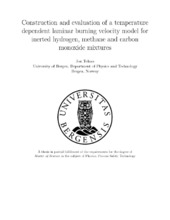Construction and evaluation of a temperature dependent laminar burning velocity model for inerted hydrogen, methane and carbon monoxide mixtures
Master thesis
Permanent lenke
https://hdl.handle.net/1956/16075Utgivelsesdato
2017-06-22Metadata
Vis full innførselSamlinger
Sammendrag
The laminar burning velocity is an important mixture property providing information about different gas mixtures’ reactivity. It is extensively used in the computational fluid dynamics (CFD) program FLACS to calculate explosion parameters such as explosion pressures, for risk management. Inaccuracy in FLACS’ laminar burning velocity model sometimes causes it to misrepresent explosion pressure trends. This model is curve fitted towards experimental results and is not calculated as a function of physical models, such as thermal diffusivity and reaction rate. The aim of this study is to construct and evaluate a product temperature dependent laminar burning velocity model with a greater physical basis. The research was confined to four different fuel − air gas mixtures, including 67 distinct mixtures, and the laminar burning velocity (S_L) model was calibrated towards a range of experimental data sets. Neither FLACS nor the S_L model are adequately precise in the current works’ domain. The S_L model shows better agreement with experiments than FLACS for the CO − air, CH4 − air and CH4 − O2 − CO2 mixtures, and a slightly better agreement for the H2 − O2 − CO2 mixtures, while FLACS shows a slightly better agreement for the C3H8 − air mixtures. It is hard to ascertain whether FLACS or the S_L model show better agreement with experiments for the H2 − air and H2 − air − steam mixtures. The SL model shows good prospect, and it is conceivable that with further enhancement it may be capable of replacing the model currently implemented in FLACS. In order to determine this, the S_L model needs to be recalibrated towards the less fitted mixtures in the current work, and be calibrated and validated towards other gas mixtures at various conditions.
